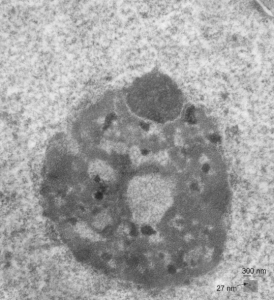Cajal bodies (that have many other names as well, best one might be nucleolar accessory body) typically have a coiled architecture. I wonder if this is part of a necessary architecture, or whether is has been recognized as such because it was easy to identify, but Cajal bodies could possibly exist without such coiling, or better yet, maybe there are several different steps in the coiling in Cajal bodies, a a coarse coiling (50 nm thread width) and a fine coiling (5 nm thickness). I vote for the latter. I think the rounded shape and polar position on the nucleolus, and the whole Cajal body size (it is a pretty large nuclear structure and was discovered first by light microscopy – the resolution of a structure there would be about 0.2 microns… so 200 nm).
My points: logs of transcriptional activity is found in neurons, in dividing cells, in cancer cells, but it has been my observation that there is also lots of activity in apoptosis. It is something I hope to pursue, that is, whether the rounded structures, perinucleolar, the right size and shape for a Cajal body, but with out the coarse thread-look) might be a variation on a Cajal body, in anticipation of taking the cell down the route to apoptosis.
Really frustrating search for other images of Cajal bodies online, and one article published in a respectable journal talks about Cajal bodies WITHOUT an ultrastructural pix — who does that.
So this nucleolus is in an hepatocyte, the hepatocyte is highly active, there is little condensed chromatin the cytoplasm is full of vesicles, and mitochondria show oxidative stress, all in all a pretty taxes cell, and the reason is that it is a Gclc ko mouse, at 28 days, without any rescue antioxidant treatment and the hepatocytes are in the process of undergoing apoptosis. So this particular nucleolus, shows no dense fibrillar component around the fibrillar centers, and it has dense areas NOT the dense granular component, ut much more coiled and dense, and i think they look like Cajal bodies (but these would be bodies that do not have the 50 nm coiling, but seemingly the very much thinner filaments, those of 5 nm) this is speculation at the moment, but I will add more info.
17740_73229_#203_mouse_wc/ii 28d, no NAC. The dark round thing i think is the Cajal body is many hundred nm in diameter, bar = 300 nm, based on the size of several ribosomes (estimated at 27 nm diameter)(inset).
